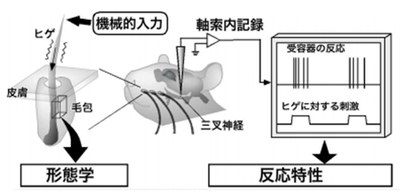
How the brain receives sense of touch revealed by examining whisking behavior of rats
A group of researchers from Osaka University and Northwestern University (U.S.) has revealed the mechanisms behind mechanoreceptor responses that underlie tactile sensation by examining the whisking behavior of rats. Mechanoreceptors (peripheral nerve terminal receptors that convert mechanical signals into neural activity) showed different response properties according to their morphological characteristics.
Tactile information (the sense of touch) is converted into neural signals by peripheral sensory receptors in the skin. Sensory neurons carry information from sensory organs to the central nervous system, i.e. the brain. To know such mechanisms is important in understanding how the brain handles tactile sensations. Tactile sensation, or mechanical stimulation, is sensed by specialized endings of sensory neurons, which transmit messages, or signals, from sensory receptors in the form of electric impulses made in response to the stimulus via the neuron’s projections to the central nervous system for interpretation and response. Since rat's facial whiskers are excellent tactile sensors, they can be used to avoid obstacles and get around in the dark. At the base of the whisker, mechanoreceptors are arranged in order.
In experiments to examine the whisking behavior of rats, the group recorded one of the peripheral nerves that carry the sensation of the whisker in order to examine the response characteristics of peripheral nerves, clarifying the relationship between their response characteristics and morphological characteristics. Of the four mechanoreceptor types they examined, only Merkel endings located at the mid-follicle level were continuously active while pushing the whisker. The other types were active only at the moments of pressing and releasing. Merkel endings responded strongly when the whisker was pushed in the direction of the mechanoreceptors.
The researchers conducted computer simulations of a theoretical model to describe this result, showing that, of the forces transmitted to the base of the whisker, the force in the "direction of whisker tilting" affected the Merkel endings, while the pushing force affected the other types. They obtained data to support the differences in characteristics between the mechanoreceptor types from 3D electron microscopic analysis.
Since rats can locate objects with their whiskers, which requires both motor and sensory signals, it is important to examine whisker-related sensory input and motor output. This group’s achievements will lead to studies of higher brain function, namely its ability to integrate information from the tactile sense and motion. Research on congruity between sensor properties and motor strategies will lead to the development of efficient active sensing for maximally reducing uncertainty.

Figure 1
The article, "The Cellular and Mechanical Basis for Response Characteristics of Identified Primary Afferents in the Rat Vibrissal System," was published in Current Biology at DOI: https://doi.org/10.1016/j.cub.2019.12.068.
